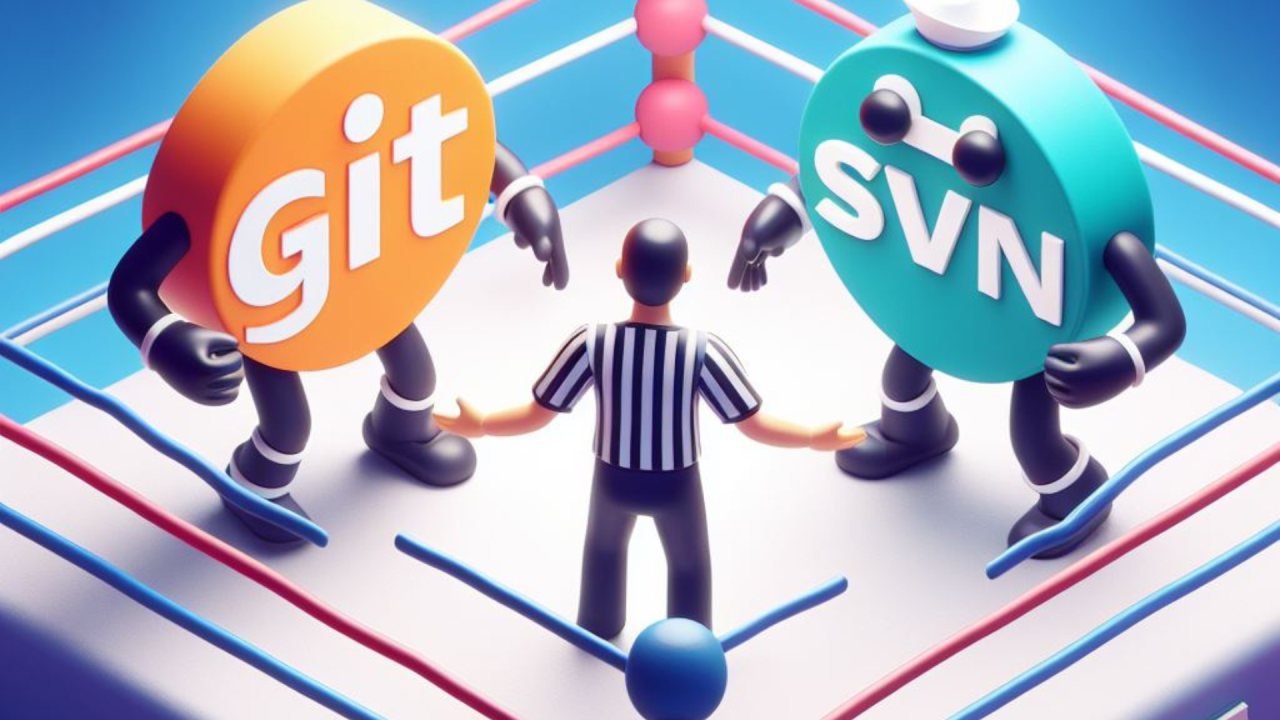SVN vs Git: Command Comparison and Usage with Examples
 Ahmed Raza
Ahmed Raza
In the world of version control, SVN (Subversion) and Git are two of the most widely used systems. Both offer tools for managing changes to code, collaborating with others, and tracking project history, but they operate in different ways and serve different needs. Understanding the key differences and commands in SVN and Git is crucial for developers working with version control systems.
In this article, we’ll explore the core SVN and Git commands, compare their usage, and demonstrate practical examples of how they can be applied in real-world scenarios.
1. Overview of SVN and Git
SVN (Subversion)
SVN is a centralized version control system (CVCS), meaning that there is a central repository where all the files are stored. Each user works with a local copy of the repository, and changes are committed to this central repository.
Git
Git, on the other hand, is a distributed version control system (DVCS), meaning every user has a full copy of the repository, including its history. This allows developers to work offline and make commits to their local repository before pushing changes to a remote server.
2. Key Differences Between SVN and Git
| Feature | SVN (Subversion) | Git (Distributed) |
| Version Control Type | Centralized | Distributed |
| Repository Structure | Central repository with local working copy | Local repository for each user |
| Branching | Often seen as heavyweight and complex | Lightweight and fast |
| Offline Work | Requires constant connection to the central server | Fully functional offline |
| Performance | Can become slower with large projects | Faster due to local operations |
3. Common SVN and Git Commands with Examples
Now that we’ve covered the basics, let’s dive into the practical commands in both SVN and Git.
3.1. Checkout/Clone
In both SVN and Git, the checkout or clone command is used to get a copy of the repository.
- SVN uses the
svn checkoutcommand:
svn checkout https://svn.example.com/repository/trunk myproject
This command checks out the trunk (default branch) from the repository to a local directory called myproject.
- Git uses the
git clonecommand to create a copy of the repository:
git clone https://github.com/example/repository.git
This command clones the entire repository, including all branches, to a local machine.
3.2. Update/Sync
To synchronize your local repository with the latest changes from the central server, you use different commands in SVN and Git.
- SVN uses the
svn updatecommand:
svn update
This command updates your local working copy with any changes made to the central repository.
- Git uses the
git pullcommand, which fetches changes from the remote repository and merges them into your local branch:
git pull origin main
This command pulls changes from the main branch in the remote repository (origin) and merges them into your local working copy.
3.3. Commit Changes
Committing changes in SVN and Git allows you to save your progress to the repository.
- SVN uses the
svn commitcommand to commit changes to the central repository:
svn commit -m "Fixed bug in user login"
The -m flag allows you to add a commit message explaining the changes made.
- Git uses the
git commitcommand to commit changes locally:
git commit -m "Fixed bug in user login"
This commits your changes to the local repository. Remember, in Git, you commit to your local repository first and then push changes to the remote repository.
3.4. View Changes
SVN and Git both offer commands for reviewing changes that have been made.
- SVN uses the
svn statuscommand to show the status of the working copy, such as modified, added, or deleted files:
svn status
- Git uses the
git statuscommand to show the current state of the working directory and staging area:
git status
This shows whether there are any uncommitted changes or files that need to be staged for commit.
3.5. Revert Changes
When working with version control, it's common to make mistakes or want to undo changes. SVN and Git both provide ways to revert changes in your working copy.
- SVN uses the
svn revertcommand to discard changes made to a file, returning it to its state in the repository.
svn revert myfile.txt
This will revert myfile.txt to the last committed version in the central repository. If you want to revert changes across multiple files, you can add the -R (recursive) flag:
svn revert -R .
- Git uses the
git checkoutcommand for undoing changes in the working directory or resetting files to a previous commit state.
git checkout -- myfile.txt
Or, to discard all uncommitted changes in the working directory:
git reset --hard
3.6. Creating and Managing Branches
Branching allows developers to work on separate features or bug fixes independently without impacting the main project.
- SVN handles branching through copies. A branch in SVN is created by copying the current repository path to a new path within the
/branchesdirectory.
svn copy https://svn.example.com/repo/trunk https://svn.example.com/repo/branches/my-feature -m "Creating a new branch for my feature"
Developers can switch between branches with the svn switch command:
svn switch https://svn.example.com/repo/branches/my-feature
- Git makes branching and merging simpler and faster. Creating a new branch in Git is straightforward:
git branch my-feature
To switch to the new branch, use:
git checkout my-feature
In Git, branches are lightweight and efficient, which encourages frequent branching and merging.
3.7. Merge Changes
Merging allows you to bring changes from one branch or revision into another.
- SVN uses the
svn mergecommand. For example, to merge changes from thefeaturebranch back into thetrunk, you would first switch totrunkand then merge:
svn switch https://svn.example.com/repo/trunk
svn merge https://svn.example.com/repo/branches/my-feature
After testing, you can commit the merged changes.
- Git offers a straightforward way to merge branches. First, switch to the target branch (e.g.,
main), then merge:
git checkout main
git merge my-feature
This merges my-feature into main. If there are conflicts, Git will prompt you to resolve them before committing.
4. Real-World Applications and Use Cases
The choice between SVN and Git depends on various factors, including project size, collaboration style, and team preferences. Here are examples of companies and situations where each version control system might be preferable:
Companies Using SVN
Apache Software Foundation: SVN is managed by Apache, and many of its projects, including the Apache HTTP Server and OpenOffice, use SVN as their primary version control system. For Apache, SVN's centralized approach aligns well with its structured development model.
Unity Technologies: Unity, the developer of the Unity game engine, relies on SVN for some of its internal code management. SVN's ease of access control and simplified workflows work well with Unity's need for structured collaboration across global teams.
Tigris.org Projects: Tigris.org, an early adopter and developer of collaborative software projects, has used SVN for several projects due to its centralization and stable structure, which simplifies managing code for larger teams.
Companies Using Git
Microsoft: Git is integral to Microsoft's development workflow, particularly with GitHub integration. Projects like Visual Studio Code and other open-source initiatives benefit from Git's distributed model, allowing for efficient collaboration and streamlined branching.
Google: Google uses Git for a variety of open-source projects, including TensorFlow and Kubernetes. Git's efficiency in handling large repositories and its collaboration tools support Google's global teams and open-source contributors.
Facebook: Facebook relies on Git for its codebase, leveraging the fast branching and merging capabilities of Git, essential for their continuous integration and deployment needs.
5. Conclusion
SVN and Git both offer essential tools for version control, yet each has its distinct advantages:
SVN: Ideal for centralized control, with straightforward permission management and access control. This makes it suitable for teams preferring a structured, central repository model.
Git: With its distributed architecture, Git provides high flexibility, offline capabilities, and faster branching and merging. It's the go-to choice for agile, collaborative, and large-scale projects.
Understanding the differences and similarities between SVN and Git enables development teams to select the right version control system for their needs, ensuring effective code management, collaboration, and project scalability.
Subscribe to my newsletter
Read articles from Ahmed Raza directly inside your inbox. Subscribe to the newsletter, and don't miss out.
Written by

Ahmed Raza
Ahmed Raza
Ahmed Raza is a versatile full-stack developer with extensive experience in building APIs through both REST and GraphQL. Skilled in Golang, he uses gqlgen to create optimized GraphQL APIs, alongside Redis for effective caching and data management. Ahmed is proficient in a wide range of technologies, including YAML, SQL, and MongoDB for data handling, as well as JavaScript, HTML, and CSS for front-end development. His technical toolkit also includes Node.js, React, Java, C, and C++, enabling him to develop comprehensive, scalable applications. Ahmed's well-rounded expertise allows him to craft high-performance solutions that address diverse and complex application needs.